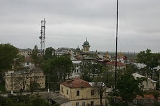
Sulina
Encyclopedia
Sulina is a town and free port
in Tulcea County
, Romania
, at the mouth of the Sulina branch
of the Danube
. It is the easternmost point of Romania and of the continental European Union
.
, from 1856 to 1939 the seat of the Danube Commission
, Sulina has become a disadvantaged location.
The reason is that the town has no road access, the only way to reach it is by boat that leaves Tulcea
and goes along the Sulina branch
of the Danube. This keeps tourists at the seaside at low numbers.
Sulina is between the Danube and the Black Sea and its location gives perfect access to both the Black Sea's beach and to visit the Danube Delta.
According to the 2002 Census, 86.0% of the population were Romanians, 11.0% Lipovans
, 1.3% Greeks, and 1.3% Ukrainians. 93.0% spoke Romanian
and 5.7% Russian
as their first language. 94.3% were Orthodox
and 5.1% Old Believers
.
Free port
A free port or free zone , sometimes also called a bonded area is a port, port area or other area with relaxed jurisdiction with respect to the country of location...
in Tulcea County
Tulcea County
Tulcea is a county of Romania, in the historical region Dobruja, with the capital city at Tulcea.-Demographics:In 2002, Tulcea County had a population of 256,492...
, Romania
Romania
Romania is a country located at the crossroads of Central and Southeastern Europe, on the Lower Danube, within and outside the Carpathian arch, bordering on the Black Sea...
, at the mouth of the Sulina branch
Sulina branch
The Sulina branch is a distributary of the river Danube, that contributes in forming the Danube Delta.The other two main branches of the Danube are the Chilia branch and the Saint George....
of the Danube
Danube
The Danube is a river in the Central Europe and the Europe's second longest river after the Volga. It is classified as an international waterway....
. It is the easternmost point of Romania and of the continental European Union
European Union
The European Union is an economic and political union of 27 independent member states which are located primarily in Europe. The EU traces its origins from the European Coal and Steel Community and the European Economic Community , formed by six countries in 1958...
.
History
Once a prosperous port and important shipyardShipyard
Shipyards and dockyards are places which repair and build ships. These can be yachts, military vessels, cruise liners or other cargo or passenger ships. Dockyards are sometimes more associated with maintenance and basing activities than shipyards, which are sometimes associated more with initial...
, from 1856 to 1939 the seat of the Danube Commission
Commissions of the Danube River
See Internationalization of the Danube River for events before 1856.The Commissions of the Danube River were authorized by the Treaty of Paris after the close of the Crimean War...
, Sulina has become a disadvantaged location.
The reason is that the town has no road access, the only way to reach it is by boat that leaves Tulcea
Tulcea
Tulcea is a city in Dobrogea, Romania. It is the administrative center of Tulcea county, and has a population of 92,379 as of 2007. One village, Tudor Vladimirescu, is administered by the city.- History :...
and goes along the Sulina branch
Sulina branch
The Sulina branch is a distributary of the river Danube, that contributes in forming the Danube Delta.The other two main branches of the Danube are the Chilia branch and the Saint George....
of the Danube. This keeps tourists at the seaside at low numbers.
Sulina is between the Danube and the Black Sea and its location gives perfect access to both the Black Sea's beach and to visit the Danube Delta.
Population
| Year | Population |
|---|---|
| 1900 | 5,612 |
| 1912 | 7,347 |
| 1930 | 6.399 |
| 1948 | 3,373 |
| 1956 | 3,622 |
| 1966 | 4,005 |
| 1977 | 4,911 |
| 1992 | 5,484 |
| 2002 | 4,601 |
According to the 2002 Census, 86.0% of the population were Romanians, 11.0% Lipovans
Lipovans
Lipovans or Lippovans are the Old Believers, mostly of Russian ethnic origin, who settled in the Moldavian Principality, in Dobruja and Eastern Muntenia...
, 1.3% Greeks, and 1.3% Ukrainians. 93.0% spoke Romanian
Romanian language
Romanian Romanian Romanian (or Daco-Romanian; obsolete spellings Rumanian, Roumanian; self-designation: română, limba română ("the Romanian language") or românește (lit. "in Romanian") is a Romance language spoken by around 24 to 28 million people, primarily in Romania and Moldova...
and 5.7% Russian
Russian language
Russian is a Slavic language used primarily in Russia, Belarus, Uzbekistan, Kazakhstan, Tajikistan and Kyrgyzstan. It is an unofficial but widely spoken language in Ukraine, Moldova, Latvia, Turkmenistan and Estonia and, to a lesser extent, the other countries that were once constituent republics...
as their first language. 94.3% were Orthodox
Eastern Orthodox Church
The Orthodox Church, officially called the Orthodox Catholic Church and commonly referred to as the Eastern Orthodox Church, is the second largest Christian denomination in the world, with an estimated 300 million adherents mainly in the countries of Belarus, Bulgaria, Cyprus, Georgia, Greece,...
and 5.1% Old Believers
Old Believers
In the context of Russian Orthodox church history, the Old Believers separated after 1666 from the official Russian Orthodox Church as a protest against church reforms introduced by Patriarch Nikon between 1652–66...
.
Sightseeing
- The Lighthouse of the European Commission of the Danube
- The Church "Sf. Nicolae"
- The Cemetery

